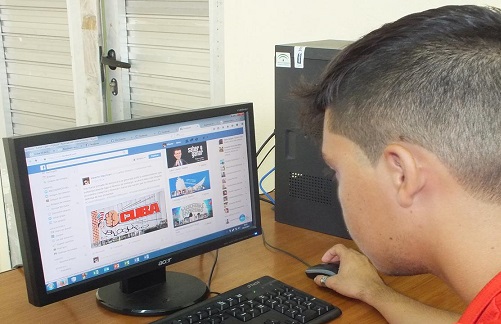

By: Santiago Romero
Translated by MSc. Guillermo Rodriguez
CTC into Cyberspace.- The Santiago de Cuba Central Union of Cuban Workers (Central de Trabajadores de Cuba, CTC in Spanish) and its fifteen unions decided to interact with its affiliates and followers, through social networks, platforms and digital blogs, in order to better communicate with different audiences in solidarity with the Cuban cause.
To this end, they not only have the national CTC website, but also they coordinate actions in the production of essential content in defense of the national and world working class.
How to do it?
In this sense, the initiative of whatsapp groups by labor groups, including work centers, communities according to trade or profession.
It starts from the necessary creation of alliances between productive and service sectors, the interrelation with jurists on the duties and rights of Cuban workers, the programming of festivals, contests, exchanges, exhibitions and musical creations, among other initiatives.
Of course, the necessary projection on the Cuban reality, the constraints of the US blockade and other measures that hinder the national workers’ movement, also towards cyberspace, a digital environment that involves training and monitoring of Cuban leaders or influencers.
The recent May Day rally showed how much strength the Cuban workers’ movement has in the network of networks, bringing joy, the united march, the dance, the banners made with the creative articulation from the factories, industries, service centers and with the support of the family, the neighborhood and the community.
Blockade disrupts production of medicine for Cuba’s national health system
And as Orlando Beltrán, secretary general of the CTC in Santiago de Cuba province, said on the May 1st speaker’s stage, many initiatives and the popular contest are needed in defense of the true national image, so manipulated in social networks and foreign media that have made of the Cuba issue a business from hatred, anger and impotence before a nation that does not kneel, although there are followers of the siren songs, sponsors of social indiscipline, crimes and corruption.
Social Networks, a New Environment of Aggression Against Cuba

Cuba shows significant rates of Internet connection
Internet- The number of residents in Cuba connected to the Internet grew to 7.7 million in 2021, 68 percent of the population, according to reports by We Are Social and Hootsuite.
Internet– Those sites, which specialize in trends, digital statistics and social networks, inform that over 600,000 Cubans went online for the first time in 2020, and the Internet penetration rate (percent of people connected) was 63.
Revolution is dialogue

of Internet connection
‘For the second year in a row the country maintains this parameter higher than the world average of 59.5 percent in the first two months of 2021,’ We Are Social and Hootsuite analyses point out.
The first joint report by both sites on Cuba recalls how the country in 2011 reached only 16 percent of the population surfing the web and the world statistic was 30 percent.
Data from Cuba’s Ministry of Communications refer that currently of the 7.7 million Cubans connected by different means, 4.2 million do so through mobile data.
Of the latter, 1.3 million work with fourth-generation cellular telephony technology (4G LTE).
Educational improvement in Cuba responds to social intelligence
Before his indecorous exit, Trump did Cuban counterrevolutionaries the favor of putting Cuba on his list of state sponsors of terrorism, another measure among the 200-plus his administration adopted with the intention of opening a hole in the map and sinking us to the bottom of the ocean.
What was the reaction of the «independent press? Whose work expands daily with the tenacity of the grateful who, for every stroke of the pen, get paid:
Oh, happy day!
The same media which, in an entirely unprofessional manner, are incapable of covering up their distortions and lies, always presented in a tendentious tone, when referring to the difficulties the country is facing, in the midst of the pandemic and the blockade sponsored by their protectors in the North, along with our own deficiencies (no denying it).
Although journalism requires constant criticism, the way in which these media exercise it is brutally counterrevolutionary, although they may deny the term, coined at the time of the French Revolution to describe the monarchy’s maneuvers intended to restore the previous socio-political order.
This is, in fact, their aspiration and that of others who, using a softer and even paternal tone, lend themselves to efforts to hide the essence of what is really at stake.























